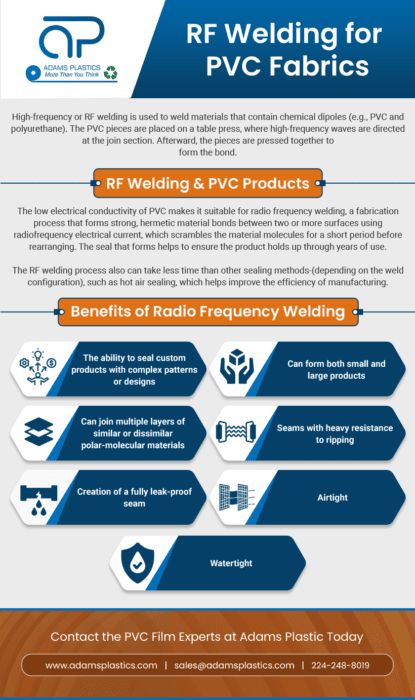Understanding PVC Welding
Polyvinyl chloride (PVC)—sometimes called vinyl—is a plastic material that comes in many variations, such as rigid or flexible, clear and opaque, and glossy or matte. It is widely available in film form, which is used to manufacture a wide range of parts and products for various home and business needs.
One of the most common manufacturing processes PVC film undergoes is welding. Through this process, it is turned into many different components for a diverse set of industrial and commercial markets, such as adhesive decals, automobile and boat seats, and medical bags.
Below, we provide an overview of the PVC welding process. We highlight what it is, what benefits it offers, how it is used, and what techniques are available.
What Is PVC Welding?
PVC welding is a plastic welding process used to permanently join separate pieces of PVC. It involves heating and/or melting the material at the join surfaces, pressing the pieces together, and allowing them to cool. Once the material on both pieces has cooled, the two pieces are bonded together at the molecular level.
Advantages of PVC Welding
Compared to other bonding methods, PVC welding has numerous advantages. For example:
- It can bond material without requiring mechanical fasteners or adhesives, which helps reduce material and equipment costs.
- It can join materials that are difficult to bond with solvent.
- It can assemble components with complex geometries or unusual bonding angles.
- It can form an airtight seal.
- It can create joined assemblies without adding a significant amount of weight.
Even in manufacturing and assembly projects where fasteners or adhesives are appropriate, welding offers unique benefits that can make it a better option. These include:
- Less surface preparation requirements
- Shorter cure and set times (depending on the welding method)
- More ergonomic joints and aesthetically pleasing bonds
- Better recyclability
Applications of PVC Welding
The above advantages and benefits make PVC welding a popular manufacturing method across a wide range of industries, including:
- Aeronautics
- Agricultural
- Automotive
- Industrial
- Marine
- Plumbing
PVC Welding Techniques
There are many PVC welding methods available, each of which has distinct characteristics that make it suitable for different joining applications.
Friction Welding
Friction or ultrasonic welding relies on friction to heat and fuse two pieces of PVC together. The pieces move relative to one another as a lateral force displaces them. This method is commonly used by manufacturers in the aerospace and automotive industries.
Extruded Bead Welding
Extruded bead welding involves the application of hot plastic between two sections of PVC. Once the plastic is applied, the sections are pressed together to form the bond.
Hot Gas Welding
Hot gas welding utilizes heat guns to soften a filler rod and the join surfaces on the PVC pieces before they are pressed together. This method is often utilized for small plumbing fittings, water tanks, and other industrial parts and products.
Hot Plate Welding
Hot plate welding employs a heated metal plate to heat the join surfaces before they are pressed together. The surface of the plate is coated with PTFE to prevent the PVC from sticking to it.
High-Frequency Welding
High-frequency or RF welding is used to weld materials that contain chemical dipoles (e.g., PVC and polyurethane). The PVC pieces are placed on a table press, where high-frequency waves are directed at the join section. Afterward, the pieces are pressed together to form the bond.
Solvent Welding
Solvent welding uses solvents to soften the join surfaces of the PVC pieces before they are pressed together. When the solvent evaporates, the pieces reharden, forming a durable bond.
Laser Welding
Laser welding utilizes a laser to heat the join line between two pieces of PVC as they are held together. The heat melts the material at the join line, forming the weld.
Induction Welding
Induction welding involves the placement of a conductive metal piece between the two pieces of PVC. A high-frequency generator is then used to heat the metal until it softens the surrounding plastic material. Once the two pieces are sufficiently softened, they are pressed together.
Contact the PVC Film Experts at Adams Plastic Today
PVC welding plays a key role in the manufacture of many industrial and commercial products. While the low cost of the material makes it a popular option for many manufacturing projects, it is important to source the material from a reliable supplier that can readily adapt to changing production needs. Otherwise, it may be difficult to accommodate greater or lesser demand in the future.
Looking for a PVC film supplier you can trust to meet your business needs on your schedule? Adams Plastics is the ideal partner. We are an industry leader in the supply of PVC films, laminates, imitation leather, and more. For more information on our products, request a sample or request a quote today.




